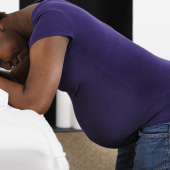The third stage of labour is the period of time between the birth of the baby and the birth of the placenta and membranes (NICE, 2023). This is a very important time and a lot of invisible work is happening inside their body to protect the woman or birthing person’s health (Reed, 2022a).
The placenta can be born physiologically with no intervention. Sometimes an injection is given to speed up the birth of the placenta. This is known as active management.
- In a vaginal birth, the placenta is born through the vagina. This might be physiological or actively managed.
- In an induced labour, or vaginal birth with forceps or ventouse, active management will be recommended.
- In a caesarean birth, the placenta is removed after the baby, through the same opening. This is always actively managed.
The midwife will discuss this with you during pregnancy and again in early labour (NICE, 2023). It is possible to express a preference for a physiological birth of the placenta in the birth plan, and the healthcare team should support that choice (NICE, 2023).
Events during labour may mean that the preference is no longer possible.
What are the placenta and membranes?
When the pregnancy implants in the wall of the uterus, the placenta, membranes and umbilical cord develop. They are part of the baby, genetically the same sex, and the only totally disposable human organ.
The baby grows within amniotic fluid held inside a bubble of membranes. This fluid protects them from bumps and infections. The membranes are attached to the placenta, which is embedded into the wall of the uterus.
During pregnancy the baby gets oxygen and nutrients from the mother or pregnant parent’s blood. These nutrients travel through the placenta and reach the baby via the umbilical cord. The baby’s waste products leave the same way.
Physiological birth of the placenta
During pregnancy, around a third of the baby’s blood is in their placenta. Once the baby is born, the lungs start working and after a while the baby no longer needs oxygen via the umbilical cord (Reed, 2022b).
Placental blood transfer
When the baby has been born but the placenta is still inside the womb, the placental blood transfers to the baby via the umbilical cord. This also means the placenta is less bulky to birth (Reed, 2022a; Reed, 2022b).
‘Optimal cord clamping’
Waiting for the umbilical cord to stop pulsing is called ‘optimal cord clamping’. It might take five minutes or a little longer for some babies (NHS, 2023; Reed, 2022b).
In situations where the baby needs resuscitation, keeping the cord intact improves the baby’s outcome (Reed, 2022b).
Placental blood includes stem cells, which may help repair any damage during the birth (Reed, 2022b).
Placenta detaches
Interactions between mother or birthing parent and baby produce more oxytocin. Interacting includes:
- touch
- smell
- talking and listening to each other
This causes the uterus to contract, and as a result the placenta peels away from the wall of the uterus (Begley et al, 2019; Reed, 2022a).
The contraction of the uterus means that the area where the placenta was attached, also seals. This stops the mother or birthing parent losing too much blood (Reed, 2022a).
Breastfeeding and skin-to-skin contact help produce more oxytocin. When the mother or birthing parent has undisturbed contact with their baby the chance of heavy bleeding is reduced (Reed, 2022a).
Pushing the placenta out
The midwife will be looking for a small gush of blood and the umbilical cord lengthening out of the vagina. This means the placenta has detached and can be born. The mother or birthing parent may feel an urge to push or may wait until they want to move (Reed, 2022a).
The midwife might encourage the woman or birthing parent to get upright, and possibly cough, to help the placenta down the vagina. The placenta is squishy and has no bones, so is easier to birth than the baby.
The midwife will check the placenta and membranes to make sure they are complete, and nothing is retained. Some parents are interested in looking at their baby’s placenta. The midwife can bag it up once it has been checked if parents wish to keep the placenta.
In summary (NHS, 2023; NICE, 2023):
- The placenta is usually born within an hour of the baby’s birth, but it can take longer
- Pushing the placenta out takes minutes
- If heavy blood loss occurs or the placenta does not come away naturally, active management will be recommended
- It’s also possible to switch to active management at the request of the mother or birthing person
Are there advantages or disadvantages to a physiological approach?
In a physiological approach:
- The baby receives all their blood and stem cells
- There are no side effects from medication
- There is no evidence that waiting to clamp and cut the cord leads to jaundice for the baby (Reed, 2022a)
- Sometimes it takes longer than an active approach
- Sometimes the placenta isn’t born, and active management is needed to prevent severe blood loss
What is active management?
Active management describes a package including an injection, clamping the cord before it has stopped pulsing, and gentle pulling on the cord (NICE, 2023).
Active management was introduced to reduce the chance of severe blood loss. However, severe blood loss is less common in high-income countries where women and birthing people are well nourished and have good healthcare (Begley et al, 2019).
- The midwife gives the woman or birthing parent an injection. This is usually oxytocin, but the choice of drug used should be discussed beforehand. Some options may mean anti-nausea medicine is also offered (NICE, 2023).
- There have been concerns that the injection given to contract the uterus crosses the placenta and reaches the baby, but there is no evidence to support that (Reed, 2022a).
- The injection is usually in the thigh, but in some circumstances (including caesarean birth) will be into a vein via thin tube called a cannula (NICE, 2023).
- This makes the uterus contract and the placenta comes away (NHS, 2023).
- The umbilical cord is clamped and cut between one and five minutes after the baby is born (NICE, 2023). This is sometimes called ‘delayed’ cord clamping, as it is later than used to be done.
- It is possible to request a few extra minutes to ensure the baby is breathing on their own, and this should be supported. Waiting longer to cut the cord is especially important for pre-term babies (Rabe et al, 2019; NICE, 2023).
- When the placenta has come away and the cord has been cut, the midwife applies gentle pressure to the umbilical cord to ease the placenta from the vagina (NICE, 2023).
- The placenta is normally born within 30 minutes of the baby being born (NICE, 2023).
- If there are concerns about the mother or birthing parent, or baby then this process may happen more quickly (NICE, 2023).
What are the advantages of active management?
- May reduce severe bleeding and anaemia. The evidence is low and only applies to women at higher risk (Begley et al, 2019).
- It is usually a little quicker, but not always (Reed, 2022a).
What are the disadvantages?
Active management may (Begley et al, 2019; NHS, 2023):
- Reduce the baby’s birthweight (as they don’t receive their placental blood)
- Increase the mother or birthing parent’s blood pressure
- Cause nausea and vomiting in the mother or birthing parent (anti-nausea drugs may be offered)
- Increase the chance of a retained placenta
- Increase afterpains in the mother or birthing parent
- Increase the chance of the mother or birthing person being readmitted to hospital with bleeding
How to choose between physiological and actively managed birth of the placenta?
A physiological birth of the placenta is only possible after a vaginal birth with no induction, forceps or ventouse. This is less likely in a hospital environment, so the decision may be linked to choice of place of birth (Reed, 2022a).
In any birth location, health professionals will always have the means to move quickly from physiological to actively managed for any reason.
What is the chance of having a blood transfusion? (NICE, 2023)
- With active management – 13 in 1000 would be expected to have a blood transfusion, while 987 would not
- With physiological birth – 35 in 1000 would be expected to have a blood transfusion, while 965 would not
What is the chance of side effects (nausea and vomiting, headache, hypertension, re-admission for bleeding)? (NICE, 2023)
- With active management – 186 in 1000 would be expected to have side effects, while 814 would not
- With physiological birth – 90 in 1000 would be expected to have side effects, while 910 would not
What is a retained placenta?
A retained placenta is where some or all of the placenta or membranes remain in the uterus after the birth of the baby. This can put the mother or birthing parent at risk of heavy bleeding (NHS, 2023).
It can happen after either a physiological or an actively managed birth of the placenta (NICE, 2023):
- If there is concern about the woman or birthing person’s condition, a vaginal examination will be offered to assess the situation.
- Pain relief for this examination will be offered
- If not in an obstetric unit, a transfer will be recommended
- If necessary, the placenta will be removed in theatre, with anaesthetic pain relief
- Care for any heavy bleeding will also happen in theatre
What might be the impact of a retained placenta?
Having a retained placenta can feel emotionally difficult. When the woman or birthing person goes to theatre for removal, then they can be anxious about the wellbeing of their baby as well as themselves.
A father or co-parent is likely to feel anxious about the wellbeing of the birthing woman or person. They will likely be handed the baby to look after and may have to wait some time for the woman or birthing person to return. At times like this, having a second birth partner can be helpful for comfort and company.
Separation of the baby from the woman or birthing person interrupts the normal hormonal flow that supports breastfeeding and bonding behaviours. This can make the breastfeeding and parenting journey feel harder.
Other placental variations to be aware of
Some placentas have more than one piece. This might be called a succenturiate lobe or bi-lobed placenta. It means that one part might be born and another retained.
Some cords don’t embed neatly into the placenta but run along the membranes. This is called vasa praevia. When the cord runs over the surface of the placenta before embedding it’s called a velamentous cord. These variations are not screened for as they are rare.
Cord blood banking
Some parents are interested in NHS cord blood donation. This is available in limited locations in the UK. It does mean that the blood goes to the bank, rather than the baby.
Commercial cord blood banking charges a fee for collection and storage. The blood remains available for the family’s own use.
What happens to the placenta?
Some parents choose not to cut the cord but wait for it to separate after around a week. This is known as ‘Lotus birth’. It means the baby, cord and placenta are kept together for that time.
If the parents have no plans for it then the placenta is discarded as medical waste. Some parents choose to take the placenta home to bury it, carry out cultural traditions or make it into remedies.
Begley CM, Gyte GML, Devane D, McGuire W, Weeks A, Biesty LM. (2019) Active versus expectant management for women in the third stage of labour. Cochrane Database of Systematic Reviews, Issue 2. Art. No.: CD007412. https://doi.org/10.1002/14651858.CD007412.pub5
NHS (2023) The stages of labour and birth. https://www.nhs.uk/pregnancy/labour-and-birth/what-happens/the-stages-o… [5 Feb 25]
NICE (2023) Intrapartum care [NG235] https://www.nice.org.uk/guidance/ng235 [4 Feb 25]
Rabe H, Gyte GML, Díaz‐Rossello JL, Duley L. (2019) Effect of timing of umbilical cord clamping and other strategies to influence placental transfusion at preterm birth on maternal and infant outcomes. Cochrane Database of Systematic Reviews, Issue 9. Art. No.: CD003248. https://doi.org/10.1002/14651858.CD003248.pub4
Reed R (2022a) An actively managed placenta may be the best option for most women. https://midwifethinking.com/2015/03/11/an-actively-managed-placental-bi… [4 Feb 25]
Reed R (2022b) The placenta: essential resuscitation equipment. https://midwifethinking.com/2016/04/13/the-placenta-essential-resuscita… [4 Feb 25]







